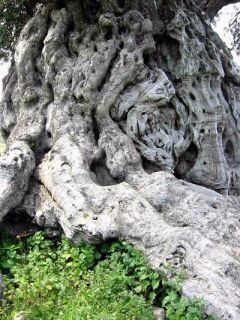» Home
» About
» Membership
» Journal
» Sparoza Garden
» Branches
» MGS Forum
» Seed Exchange
» Donations
» MGS Excursions
» Information
» Members' Gardens
» Book Reviews
» News & Views
» Contact
» Search
|
Spring In Greece
Visits made by the Greek Branch in Spring 2002
The Olive Grove
Words and photos by Davina Michaelides
On an overcast morning in early spring, I walked along country pathways, with other members of the Society, to the ancient olive grove on the island of Aegina, only an hour's sail from the busy port of Piraeus……yet a world away! The weather was cool, the company pleasant, the grass fresh and the spring flowers abundant and crisp after the unusually wet spring.
And then we came upon the olive grove. So ancient. So silent. So peaceful. So worthy of our respect…and protection. The oldest tree in the grove, with its three trunks, is believed to be 1800 years old, one of the oldest olive trees in Europe, yet it still flowers and was in full bloom when we saw it! But the trunk and roots were what really impressed us and captured our imagination!
Stratis Myrivillis describes it perfectly.
“The trees' trunks are tormented by an agonized striving. They are twisted, they kneel to pray, they raise their strong arms, members tyrannized by movement, all elbows and knees. The bent roots suck the golden oil from the heart of the earth, for the lamps of the saints and for the salads of the poor” I've been told by friends who live on Aegina, that several years ago a gypsy family of five lived inside its hollow trunk. How apt that this tree had the opportunity to be a benevolent mother offering shelter within her twisted arms to a family in need. Indeed, how many other families has she helped over the centuries with her oil, fruit and wood?
The ancient Greeks believed that the cultivated olive (Olea europaea) was purely Greek and that its homeland was Athens. When the gods wanted to name the city but couldn't decide whether to give the honour to Athena or Poseidon, each was asked to produce a gift, both useful and beautiful, to benefit mankind.
Poseidon struck a rock with his trident and a wonderful horse sprang forth… (although others say it was a spring called Erectheis that sprang from the rock.) Athena then struck the rock with her spear and a gigantic olive tree appeared. Judging the olive to be the more important gift to mankind, the gods named the city after her.
Herodotus (V111, 55), referring to this olive tree, tells us how it was burnt down, along with the sanctuary to Athena, when Xerxes set fire to Athens in 480 B.C. Interestingly, the day after the fire, a new shoot about half a metre in length had already sprung from the charred trunk and the tree survived, adding to its reputation of immortality. This tree [also mentioned by Pausanias (1,27,2)] was later called the “Hunchback” because of its age and twisted, agonized shape.

The ancient olive grove.

The ancient olive tree with sea squill, Urginea maritima, in the foreground.
These bulbs, the size of a baby's head, are dug up when the first leaves appear
and given as New Year gifts. They are hung over doorways to offer protection
from evil spirits and unwelcome guests and to impart a life force to the house,
and its inhabitants. The leaves disappear into the bulb during the hot summer
months and a tall candle-like flower appears in the autumn.

The three trunks showing the hollow center with yellow
broom in the background.

Close-up of the trunk with Urtica pilulifera in the foreground.
See also: Kea by Davina Michaelides
|


